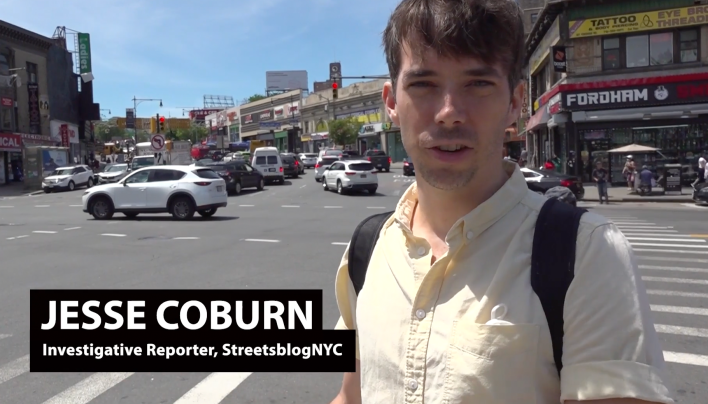School zones don’t have to be danger zones.
That’s the glaring finding from this year’s “first day of school” video from Streetfilms, which documents not only how unsafe our children are as they arrive or depart school every day, but how easy it is to fix the problem. The title alone gets it in a nutshell: “School Streets: Safe Space for Kids to Thrive”:
The film features Streetsblog reporter Jesse Coburn and builds on his stunning and horrifying reporting earlier this year.
In one deep-dive investigation, Coburn discovered that on school days, streets near schools are more dangerous on average than other city streets. During the 8 a.m. hour, when hundreds of thousands of children stream into 1,600 city-run public schools, there are 57 percent more crashes and 25 percent more injuries per mile on streets near schools than on non-school streets. This disparity largely disappears on days when schools are closed.

Drivers crash nearly 50 times and injure a dozen people near city public schools during the average day when schools are open.
And the danger is inequitable: In the 2019 school year, the rate of people injured by drivers on school days was 43 percent higher outside school buildings where a majority of students were brown or Black than outside school buildings with majority-white students.
Coburn also reported in June that the city’s open streets for schools program is failing to deliver on the promise of keeping car drivers away from our most vulnerable road users. Only 38 schools were taking advantage of the pandemic-era program, down from just 101 a few months earlier. And those three dozen schools were hardly representative of schools citywide: they are located in Census tracts that on average are far wealthier and whiter than the rest of the city, according to a Streetsblog analysis of Census data.
The danger that children face from car drivers is not limited to crashes. Pollution is higher on blocks with more cars, and open streets promote independence in children, said former DOT Commissioner Janette Sadik-Khan, who also appears in the film.
“We’re giving kids the ability to walk and get around on their own,” she said, marveling at the 34th Avenue open street in Jackson Heights, which has been turned into “Paseo Park” since Sadik-Khan visited earlier this year. “That is the secret sauce of a good city.”
StreetopiaUWS Director Carl Mahaney points out in the film that the application process for the city’s open streets program for schools is onerous on parent groups or the schools themselves because it is an opt-in system rather than a universal service provided by the city to keep its kids safe.
Coburn discovered that in a story this week profiling one Manhattan school that can’t seem to get its school street application approved … for no good reason.
The application process is so difficult that the livable streets group Open Plans (a sister organization to Streetsblog) will release on Monday a one-page “cheat sheet” for school communities for getting through the bureaucratic maze. We’ll have full coverage.






